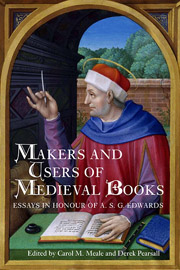Book contents
- Frontmatter
- Contents
- List of Illustrations
- Contributors
- Preface
- List of Abbreviations
- COMPOSITION
- Winning and Wasting in Wynnere and Wastoure and Piers Plowman
- The Reference Work in the Fifteenth Century: John Whethamstede's Granarium
- Pageants Reconsidered
- COMPILATION
- PRODUCTION
- OWNERS, PATRONS, READERS
- AFTERLIVES
- A. S. G. Edwards: List of Publications
- Index of Manuscripts and Early Printed Books
- General Index
- Tabula Gratulatoria
Pageants Reconsidered
from COMPOSITION
Published online by Cambridge University Press: 05 May 2014
- Frontmatter
- Contents
- List of Illustrations
- Contributors
- Preface
- List of Abbreviations
- COMPOSITION
- Winning and Wasting in Wynnere and Wastoure and Piers Plowman
- The Reference Work in the Fifteenth Century: John Whethamstede's Granarium
- Pageants Reconsidered
- COMPILATION
- PRODUCTION
- OWNERS, PATRONS, READERS
- AFTERLIVES
- A. S. G. Edwards: List of Publications
- Index of Manuscripts and Early Printed Books
- General Index
- Tabula Gratulatoria
Summary
The term ‘pageant’ was rather loosely defined in the late medieval period. It may refer to a dramatic scene, to an individual play in a mystery cycle, or to an element in a procession or royal welcome, as one might expect, but also alludes to images and texts presented together in manuscripts or in paintings. In a characteristically brief but provocative note, Tony Edwards defines ‘pageant’ as ‘ a synonym for “picture” or “illustration” during the late Middle English period’, drawing this conclusion from his observations of manuscript evidence. His examples include a scribal note in Cambridge, St John's College MS 208 (H.5), a description of a manuscript in a 1463 entry in the register of the Parish Fraternity of St Botolph, and notes to illuminators in Oxford, Corpus Christi College MS 237. Here, however, Edwards's additions to the more generally received notions of the meaning of the word ‘pageant’ are considered more broadly to include both literal pictures and figurative ones. While the word ‘pageant’ principally refers to individual plays in the mystery cycles or to the wagons on which they were staged (to which this essay alludes only briefly), other late medieval and Tudor uses seem to expand the meaning of the term further, which this essay explores. These meanings include notions of a pageant as a painting, as a false representation, as a theatrical prop or tableau, or even as a scene from life, picturing an historical moment or creating a memorial of that moment.
- Type
- Chapter
- Information
- Makers and Users of Medieval BooksEssays in Honour of A.S.G. Edwards, pp. 34 - 47Publisher: Boydell & BrewerPrint publication year: 2014



